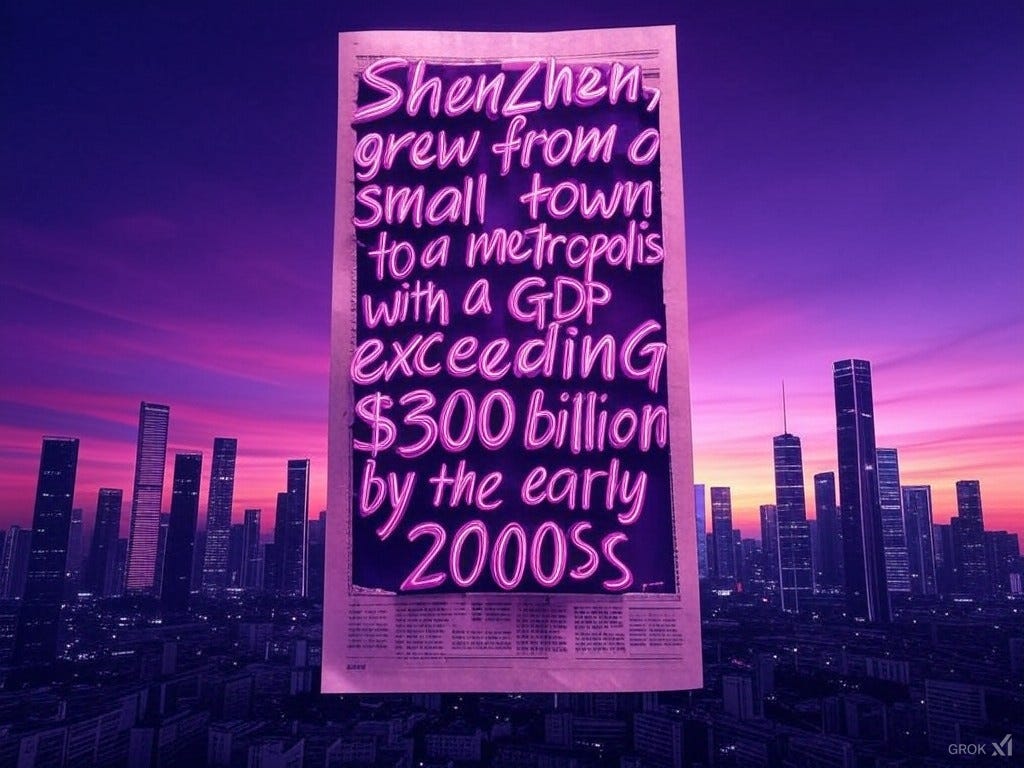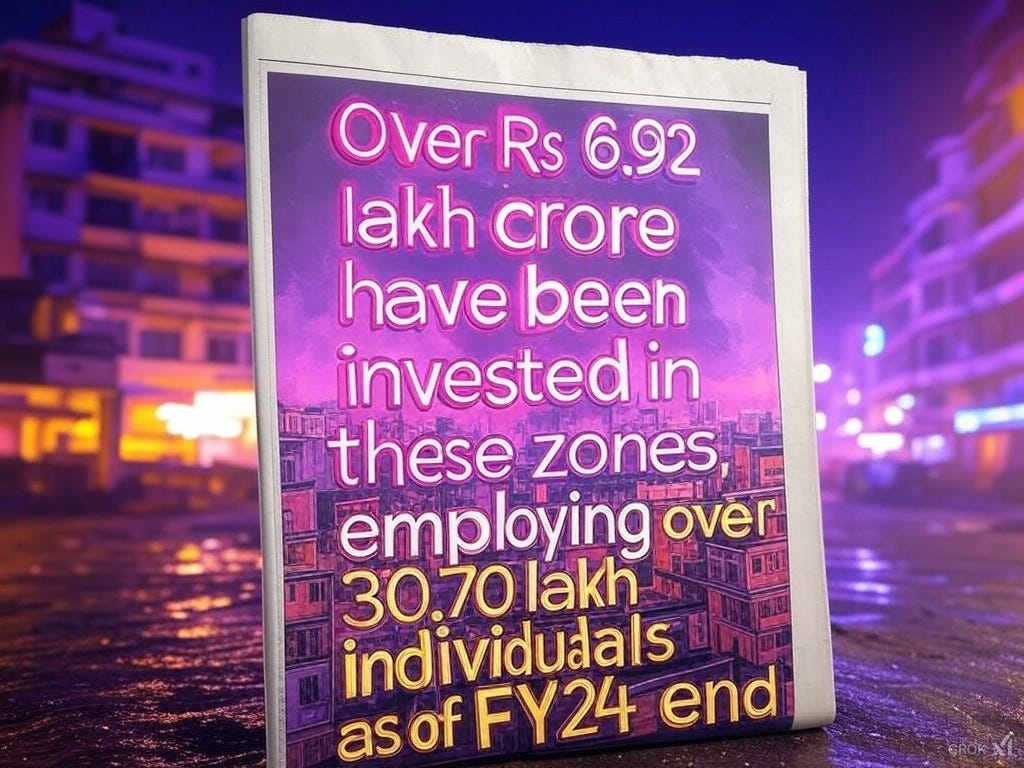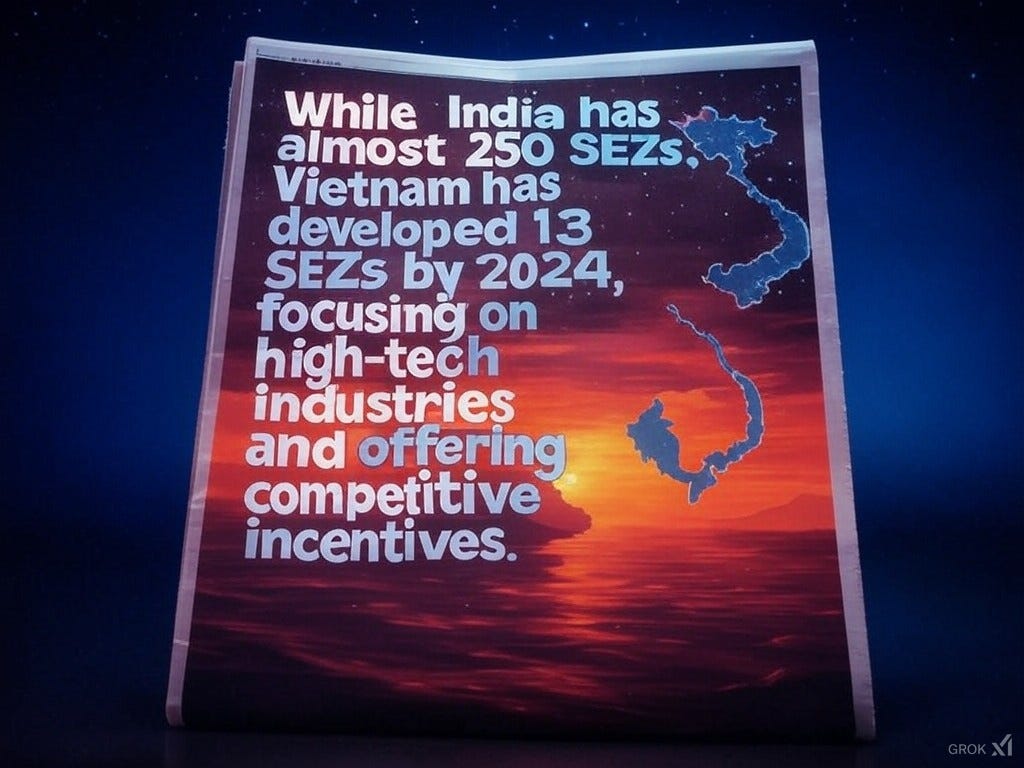#3: Decoding the rise of India's SEZs, the Chinese inspiration and more!
Today, we explore the fascinating journey of Special Economic Zones (SEZs) in India, a tale where billions in foreign investment meet the ambition of boosting exports!
The role of SEZs in attracting foreign investment and boosting export-oriented industries.
Welcome to Bharatnama, where we dive deep into the heartbeat of India's economic evolution.
Today, we explore the fascinating journey of Special Economic Zones (SEZs) in India, a tale where billions in foreign investment meet the ambition of boosting exports, with India's SEZs currently generating over $100 billion in annual exports!
Let's journey through time to understand how these zones have shaped, and continue to shape, India's place on the global stage.
..
See, in the early 1960s, when India was still finding its footing in the post-independence era, the concept of SEZs was not yet in the lexicon.
And it was only in 1965, that the seeds were sown with the establishment of the first Export Processing Zone (EPZ) in Kandla, Gujarat.
This was Asia's first EPZ, designed to promote exports by creating a controlled environment for manufacturing and trade. This was aimed at overcoming the shortcomings of the multiplicity of controls and clearances, the absence of world-class infrastructure, and an unstable fiscal regime.
And, the goal was simple: to attract foreign investment through incentives and create jobs.
However, these initial zones were limited in scope and faced numerous bureaucratic hurdles. Thus, they struggled to achieve their full potential.
For example, by the late 1990s, India's EPZs had attracted only about $8 billion in investment and generated just over $5 billion in exports annually.
..
The narrative took a real and significant turn in April 2000 when India announced its SEZ policy aiming to mimic the successes seen in other parts of Asia, particularly China and ASEAN.
China's SEZs, starting with Shenzhen in 1979, had become beacons of economic prosperity, transforming regions into global manufacturing hubs.
Shenzhen, for instance, grew from a small town to a metropolis with a GDP exceeding $300 billion by the early 2000s.
And by this time, overall, China's SEZs were contributing an estimated 20% to the nation's GDP and accounted for over 40% of its total foreign direct investment.
Inspired by this, India's policy was crafted to provide tax holidays, duty-free import of machinery, and simplified regulations, hoping to replicate this model.
It was aimed at attracting larger foreign investments by providing a stable fiscal regime and quality infrastructure.
..
And it was this pursuit, which led the country to the enactment of the Special Economic Zones Act of 2005, which was a landmark legislation.
It was passed by Parliament in May 2005, aiming to create an engine for economic growth with minimum regulations.
This act received presidential assent on 23 June 2005, and by 2024. It formalized these zones, distinguishing them from the earlier EPZs by enhancing the scale and incentives.
It introduced a 100% income tax exemption for the first five years, a 50% exemption for the next five years, and a 50% exemption on export profits for the next five years.
It also allowed for duty-free imports of capital goods and raw materials, streamlined environmental clearances, and simplified labour laws.
By 2006, the rules were set, and SEZs began to proliferate across India, with states like Tamil Nadu, Telangana, Gujarat and Maharashtra becoming hotbeds for these zones.
Overall, it has led to the establishment of 272 operational SEZs across India as on this date.
..
The operational dynamics of these SEZs are managed by developers, both private and public, who set up world-class infrastructure to attract businesses.
The developers are required to provide world-class infrastructure, including dedicated power supply, high-speed internet connectivity, efficient transportation networks, and modern warehousing facilities.
For instance, the Mahindra World City SEZ in Chennai boasts a 1,500 MW dedicated power plant, a state-of-the-art water treatment facility, and a dedicated logistics hub.
Likewise, companies like Reliance Industries and Tata Consultancy Services (TCS) have been pivotal in developing and operating SEZs.
On one hand, companies like Reliance have seen this as a business opportunity, building many of India’s most successful SEZs in Haryana, Mumbai, Tamil Nadu etc.
On the other hand, companies like TCS, with a presence in several SEZs, have not only benefited from the incentives but also fueled employment and services exports for the country.
..
Anyhow, the point is that with the policy set in motion in 2006, the economic impact began to manifest.
From 2005-06 to 2023-24, exports from SEZs in India leapt from Rs 22.8k crore to INR 7.59 lakh crore. That’s a massive 33-fold jump.
And, this has been an outcome of over Rs 6.92 lakh crore have been invested in these zones, employing over 30.70 lakh individuals as of FY24 end.
Of that massive investment, sectors like IT/ITeS have attracted over Rs 2 lakh crore, which has driven the formation of an industry which logged Rs 5.1 lakh crore of exports from the SEZ operations in the fiscal year 2023-24 alone!
Likewise, pharmaceuticals with Rs 50k crore, and textiles with Rs 30k crore or so have been other big gainers of investments.
Furthermore, the SEZs have generated diverse employment opportunities, with over 10 lakh jobs in IT/ITeS, 5 lakh in manufacturing, and 3 lakh in the textiles sector.
..
However, the journey was not without its challenges. The biggest of these is the land acquisition challenge.
Despite the economic benefits, SEZs have faced land acquisition disputes, leading to social unrest in some areas.
For instance, the proposed SEZ in Nandigram, West Bengal, faced significant opposition from farmers, resulting in protests and ultimately the abandonment of the project.
Moreover, the policy has sometimes been criticized for disproportionately benefiting large corporations over SMEs, leading to debates about equitable growth.
Also, the competition from other countries with similar models, like Vietnam, which has been aggressively scaling its own SEZs, poses a continuous challenge.
And, while India has almost 250 SEZs, Vietnam has developed 13 SEZs by 2024, focusing on high-tech industries and offering competitive incentives.
This has attracted significant FDI, particularly in manufacturing sectors previously dominated by China, making it a formidable competitor in attracting FDI, especially from tech giants looking for alternatives to China.
..
Anyhow, the positive thing is that in terms of recent developments, India has seen significant investments in its SEZs.
For example, the Kandla SEZ has been instrumental in generating exports worth US$38 billion in FY 2022-23, largely due to its strategic location and the incentives offered.
But, the problem, as mentioned above, is that globally, India's SEZs face competition not only from China, with its sophisticated SEZ infrastructure and vast market, but also from the US, where economic zones are less about physical boundaries and more about tax incentives and innovation hubs like Silicon Valley.
Here, the focus is on high-tech industries, and the model is less about physical zones and more about clusters of innovation, which contrasts with the land-based, manufacturing-oriented zones in India and China.
..
Looking forward, the future of SEZs in India hinges on several factors.
The government's push towards making India a manufacturing hub through initiatives like the Production-Linked Incentive (PLI) scheme aligns with SEZ objectives.
The PLI scheme announced to boost local manufacturing with incentives worth billions, particularly in electronics, could significantly bolster SEZ activities.
However, the challenge lies in ensuring these zones do not become isolated islands of prosperity but are integrated into the broader economic fabric, benefiting all sectors of society.
In all fairness, the narrative of SEZs in India is one of ambition, adaptation, and aspiration.
From the initial EPZs to today's sprawling SEZs, the journey has been about learning, adapting global best practices, and sometimes, facing the harsh realities of economic policy implementation.
As we look to the future, the story is still unfolding, with each new policy tweak, investment, and export milestone adding a chapter to this ongoing saga of economic transformation through strategic zones.
Thus, this exploration of SEZs in India is about understanding how a nation leverages its economic tools to carve a niche in the global marketplace.
As we close this edition of Bharatnama, we continue to watch, analyze, and narrate how these zones will shape India's economic landscape in the decades to come.
Stay tuned!
Best,
Sumedh, building EMotorad
Taking made-in-India e-cycles to every country in the world, from Pune with love
Sharing insights from the entrepreneurial journey on LinkedIn
Jayant, building Biz News+
Sharing non-trending insights from the world of business & economy with ~25k investors on WhatsApp and ~80k readers on LinkedIn daily
And building Deepdives with Jay and Decoding the Dragon newsletters read by ~2.6k and ~2.8k subscribers










